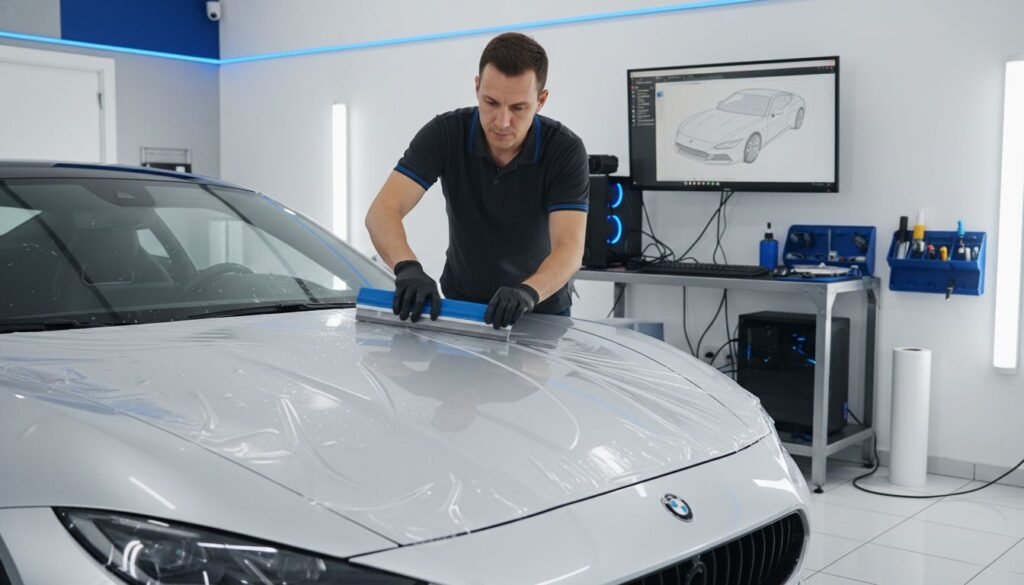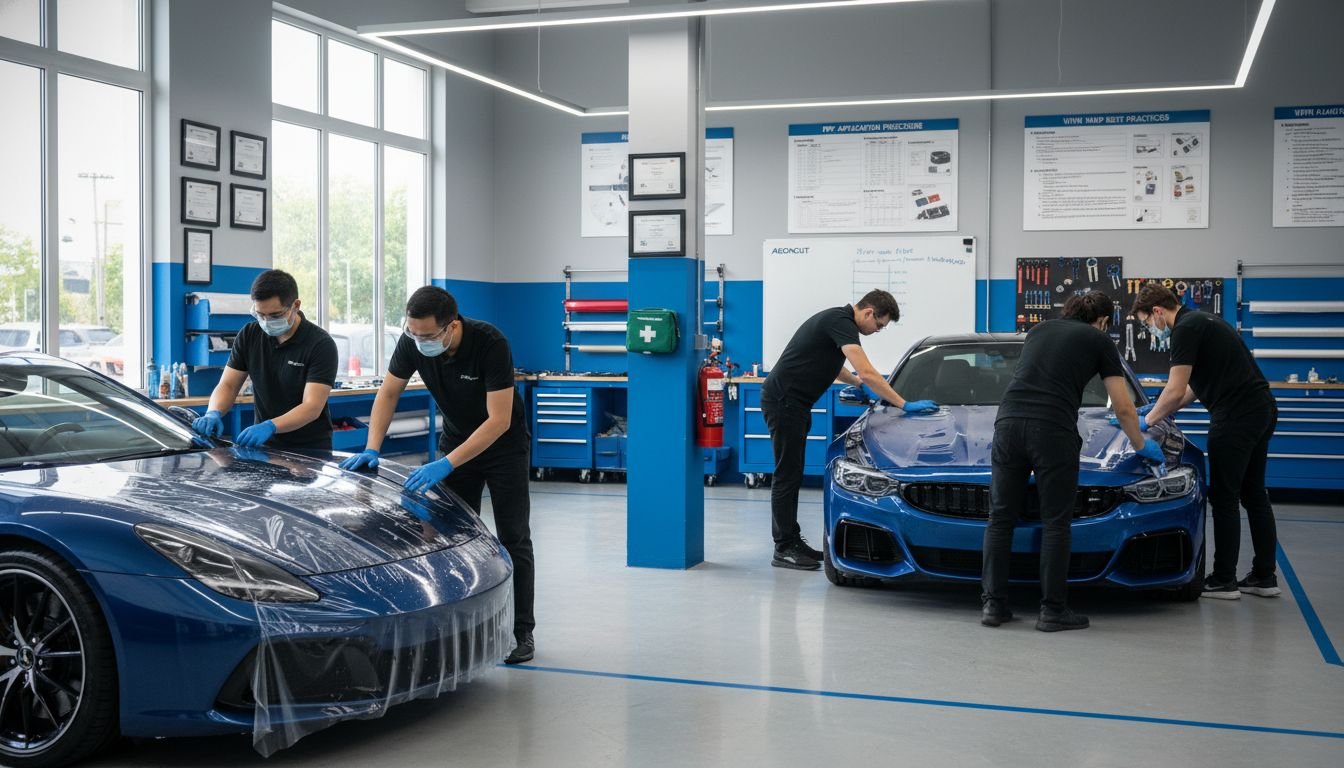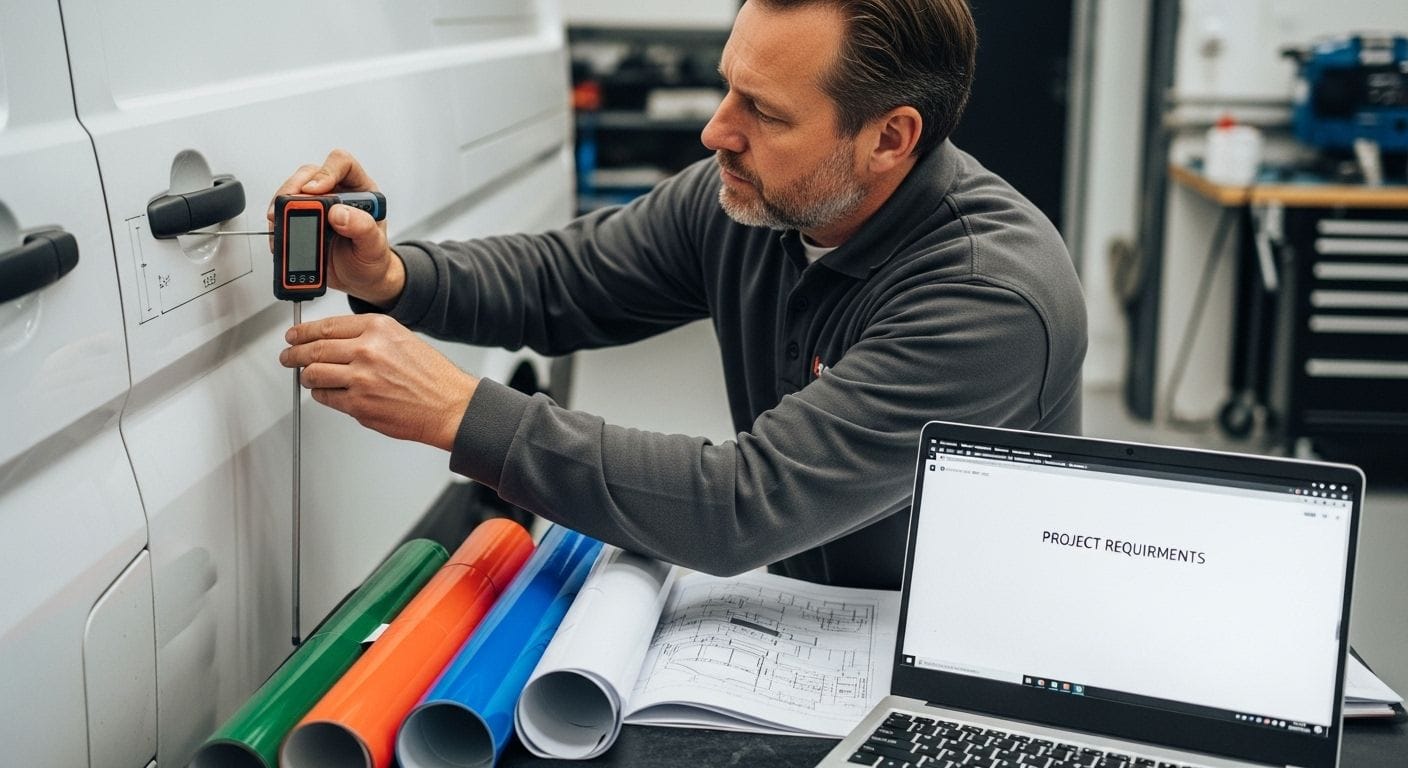
Protecting your car’s paint is more than just a cosmetic concern. Scratches, chips, and harsh weather can quickly eat away at resale value, with repairs often costing hundreds to thousands each year. Paint Protection Film, or PPF, offers a high-tech shield that helps keep vehicles looking new longer. Understanding the real cost and value of PPF can help car owners and professionals choose smart, lasting protection for any vehicle.
Table of Contents
- What Is PPF for Car Price?
- Types of PPF Films and Their Distinctions
- Factors Affecting PPF Pricing and Value
- Installation Process: Professional Vs DIY
- Comparing PPF Costs to Other Protection Options
Key Takeaways
| Point | Details |
|---|---|
| PPF Definition | Paint Protection Film (PPF) is a thermoplastic film that protects vehicle paint from environmental damage, ensuring aesthetic and market value retention. |
| Types of PPF | Various PPF types, including TPU and self-healing options, cater to different protective and aesthetic needs for vehicles. |
| Cost Factors | PPF pricing is influenced by factors such as film quality, coverage area, installation method, and warranty length. |
| Professional Installation Benefits | Professional PPF installation minimizes risks of misalignment and damage, providing superior quality compared to DIY methods. |
What Is PPF for Car Price?
Paint Protection Film (PPF) represents a sophisticated automotive surface preservation technology designed to shield vehicle paintwork from environmental damage. According to Wikipedia, PPF is a thermoplastic urethane film applied to critical vehicle surfaces to protect against stone chips, bug splatters, and minor abrasions.
PPF serves as a crucial investment for vehicle owners seeking to maintain their car’s aesthetic and market value. The film acts as an invisible shield, absorbing impacts and preventing direct damage to the original paint surface. Professional installers typically apply PPF to high-impact zones like the hood, front fenders, side mirrors, and other vulnerable areas that experience frequent exposure to potential scratching or chipping.
Modern PPF technologies offer remarkable protective characteristics. Elov PPF highlights three primary PPF categories: Thermoplastic Polyurethane (TPU), Modified Thermoplastic Polyurethane (TPH), and Polyvinyl Chloride (PVC). Among these, TPU PPF is particularly prized in the high-end automotive market due to its exceptional properties:
- Superior elasticity
- Advanced self-healing capabilities
- Remarkable resistance to yellowing
- Enhanced durability against environmental stressors
By investing in high-quality PPF, car owners can effectively preserve their vehicle’s pristine appearance and potentially maintain a higher resale value.
 For professionals seeking precise PPF pre-cut patterns for installation, advanced software solutions like AEONCUT offer comprehensive cutting templates to streamline the protection process.
For professionals seeking precise PPF pre-cut patterns for installation, advanced software solutions like AEONCUT offer comprehensive cutting templates to streamline the protection process.
Types of PPF Films and Their Distinctions
Paint Protection Film (PPF) encompasses a diverse range of specialized films designed to meet various automotive protection needs. According to PDR TX Smart Auto Repair, the PPF market offers several distinctive types tailored to different aesthetic and protective requirements.
The most prevalent PPF variations include textured films with unique finishes like carbon fiber, which provide both protection and visual enhancement. Professionals can choose from multiple material compositions, each offering specific advantages. The primary categories include Thermoplastic Polyurethane (TPU), Modified Thermoplastic Polyurethane (TPH), and specialized variants with enhanced characteristics.
Key PPF film types showcase remarkable diversity in their protective capabilities:
- Black PPF: Ideal for accent areas and creating dramatic visual contrast
- TPU-based PPF: Renowned for exceptional flexibility and durability
- TPH-based PPF: A cost-effective alternative with solid protective properties
- Polycarbonate-infused PPF: Offers superior toughness and impact resistance
- Self-healing PPF: Automatically repairs minor scratches, maintaining pristine appearance
For professionals seeking precise application techniques, comparing different PPF finishes becomes crucial in selecting the optimal film for specific vehicle protection requirements. Advanced software solutions like AEONCUT can further streamline the selection and installation process, ensuring automotive professionals achieve optimal results with their chosen PPF type.
Factors Affecting PPF Pricing and Value
Paint Protection Film (PPF) pricing is a complex landscape influenced by multiple critical factors that automotive professionals must carefully consider. Automotive Specialty Wraps reveals that professional PPF installation costs can range dramatically from $1,000 to $5,000, depending on several key variables that impact overall value and performance.
The primary determinants of PPF pricing include film quality, coverage area, installation complexity, and long-term durability. Material composition plays a significant role, with premium films offering advanced features like self-healing properties, enhanced UV resistance, and superior scratch protection. Professional-grade films typically command higher prices due to their sophisticated technological attributes and proven performance characteristics.
Key factors influencing PPF pricing and value encompass:
- Film Quality: Thickness, material composition, and technological features
- Coverage Area: Partial vs. full vehicle coverage
- Installation Expertise: Professional vs. DIY application
- Brand Reputation: Established manufacturers with proven track records
- Warranty Duration: Length and comprehensiveness of protection guarantee
Premier Auto Styling emphasizes that while professional installations are more expensive upfront, they offer superior quality and longevity, often lasting five to ten years compared to DIY applications that might require reapplication every one to two years. For professionals seeking precision in PPF selection and application, exploring top PPF benefits can provide crucial insights into making cost-effective protection decisions.
Installation Process: Professional Vs DIY
The Paint Protection Film (PPF) installation process presents two distinct approaches: professional application and do-it-yourself (DIY) methods, each with unique implications for vehicle protection and aesthetic quality. LeJeune Ceramic Coating highlights that professional installations minimize risks through specialized expertise and advanced tools, ensuring precise and comprehensive coverage.
Professional installers bring critical advantages to the PPF application process. Specialized training enables them to navigate complex vehicle contours, manage intricate film placement, and utilize advanced techniques that DIY enthusiasts might struggle to replicate. Their approach involves meticulous surface preparation, precise film alignment, and technical skills developed through extensive experience with various vehicle models and film types.
Key differences between professional and DIY PPF installation include:
- Precision: Professional installers guarantee near-perfect film alignment
- Equipment: Access to specialized tools and climate-controlled environments
- Technique: Advanced methods for bubble elimination and seamless application
- Preparation: Comprehensive surface cleaning and paint correction
- Warranty: Professional installations often include comprehensive protection guarantees
CM3 Detail emphasizes the significant risks associated with DIY applications, such as potential air bubbles, misalignment, and uneven coverage that can compromise both protective capabilities and visual aesthetics. For professionals seeking to enhance their installation precision, exploring advanced cutting software techniques can provide crucial insights into achieving optimal results.
Comparing PPF Costs to Other Protection Options
Navigating vehicle protection options requires a comprehensive understanding of costs, longevity, and effectiveness across different solutions. Automotive Specialty Wraps reveals that professional Paint Protection Film (PPF) installations range from $1,000 to $5,000, reflecting the sophisticated materials and precision application techniques employed by automotive protection specialists.
Comparative protection methods each present unique cost considerations and performance characteristics. Ceramic coatings, traditional waxing, sealants, and PPF represent the primary vehicle protection strategies, with significant variations in initial investment, durability, and long-term maintenance expenses. Professional PPF installations stand out for their comprehensive protection and potential to preserve vehicle aesthetic and monetary value over extended periods.
Key cost and protection comparisons include:

- PPF: High initial cost, 5-10 years protection, superior physical damage prevention
- Ceramic Coating: Moderate cost, 2-5 years durability, excellent chemical resistance
- Traditional Wax: Low cost, short-term protection (weeks to months)
- Sealants: Moderate cost, intermediate protection (6-12 months)
- Vinyl Wraps: Variable cost, primarily aesthetic protection
Premier Auto Styling emphasizes that while DIY protection methods might seem economical initially, they frequently require more frequent reapplication, ultimately increasing long-term expenses. For professionals seeking precise protection strategies, comparing PPF versus alternative coatings can provide critical insights into making cost-effective automotive preservation decisions.
Enhance Your PPF Application and Protect Your Car’s Value with AEONCUT
Understanding the complexities of Paint Protection Film pricing and installation is crucial for maintaining your vehicle’s pristine look and resale value. This article highlights challenges such as selecting the right film type, managing installation precision, and balancing cost with quality — all vital for professional installers and serious car enthusiasts. The pain of misaligned cuts, material waste, and inconsistent coverage can undermine both protection and appearance. AEONCUT’s advanced PPF software is designed specifically to address these issues with precision pre-cut patterns and cutting-edge features like AI-driven auto-nesting to reduce waste and installation errors.

Ready to take your Paint Protection Film installations to the next level with confidence and efficiency? Explore our extensive library of PPF precut patterns and unlock tools tailored for professional results. Don’t let costly mistakes erode your investment or reputation. Visit https://aeoncutsw.com today and revolutionise the way you protect your vehicles’ finish with AEONCUT’s precision and reliability.
Frequently Asked Questions
What is Paint Protection Film (PPF) and how does it work?
PPF is a thermoplastic urethane film applied to a vehicle’s surface to protect the paint from damage caused by environmental factors such as stone chips, bug splatters, and minor abrasions. It acts as an invisible shield that absorbs impacts and helps preserve the vehicle’s appearance.
How much does the installation of PPF typically cost?
The cost for professional PPF installation can vary widely from $1,000 to $5,000, influenced by factors such as film quality, coverage area, installation complexity, and brand reputation.
What factors should I consider when choosing between PPF and other car protection options?
When comparing PPF to other protection methods, consider cost, longevity, and effectiveness. PPF offers superior physical damage prevention and typically lasts 5-10 years, while other methods like ceramic coatings and sealants have shorter lifespans and varied levels of protection.
Can I install PPF myself or is it better to hire a professional?
While DIY installation of PPF is possible, professional application is generally recommended due to the expertise and specialized tools required. Professionals ensure precision, avoid common mistakes, and often provide warranties for their work.
Recommended
- Building a PPF Business in 2025: From Tools to First Clients – AEONCUT PPF Pre-cut Cutting software
- Building a PPF Business in 2025: From Tools to First Clients – AEONCUT PPF Pre-cut Cutting software
- Building a PPF Business in 2025: From Tools to First Clients – AEONCUT PPF Pre-cut Cutting software
- Building a PPF Business in 2025: From Tools to First Clients – AEONCUT PPF Pre-cut Cutting software



